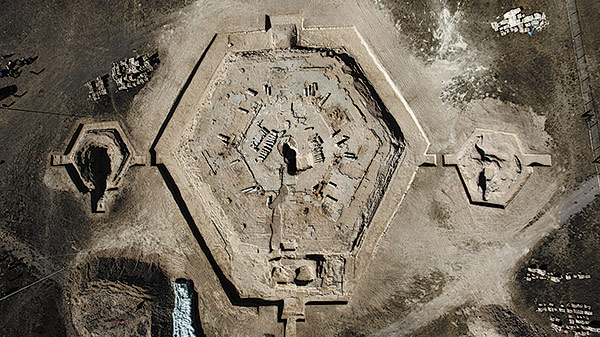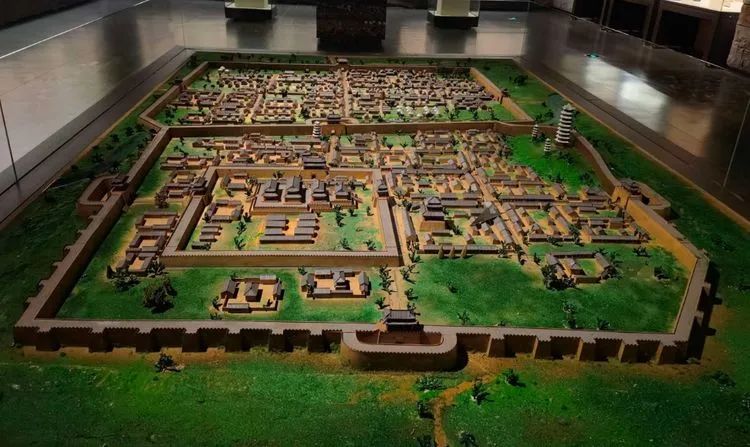Exploring Liao Shangjing Ruins: The Ancient Capital of the Liao Dynasty

An Essential Guide to Visiting Liao_Shangjing_Ruins
Nestled in the rolling hills of Inner Mongolia, the Liao Shangjing Ruins stand as a magnificent testament to the grandeur of the Liao Dynasty, an era often overshadowed by its contemporaries. Established over a millennium ago, this ancient capital—also known as Shangjing—was a thriving hub of political, military, and economic activity, boasting impressive architecture and vibrant urban life. Visitors to the site are greeted by the remnants of a once-grand city, including the majestic imperial citadel and distinct brick towers that rise against the skyline, evoking a sense of historical wonder.
As you wander through the expansive ruins, you can almost hear the echoes of the Khitan people, who forged a powerful empire that spanned across northern China and beyond. The ruins encompass a sprawling area divided into northern and southern sections, each telling a unique story of its time. The imperial city, with its imposing walls and ornate palaces, was the seat of power for centuries, while the southern city served as a residential area for the Han Chinese, illustrating the rich cultural tapestry of the region.
Whether you’re a history enthusiast eager to delve into the past or a traveler seeking to experience the serene beauty of ancient landscapes, the Liao Shangjing Ruins offer an unforgettable journey through time. Explore the intricate architecture, marvel at the impressive scale of the site, and immerse yourself in the rich heritage of the Khitan civilization. This guide will equip you with everything you need to make the most of your visit, ensuring that your adventure to this remarkable site is both enlightening and enjoyable.
In This Guide
- An Essential Guide to Visiting Liao_Shangjing_Ruins
- The Rich History and Legends of Liao_Shangjing_Ruins
- Main Highlights: What You Absolutely Can’t Miss
- Planning Your Visit: A Practical Guide
- Tickets: Prices, Booking, and Tips
- How to Get There: A Complete Transportation Guide
- Local Cuisine and Accommodation Nearby
- Frequently Asked Questions
- Final Thoughts on Your Trip
The Rich History and Legends of Liao_Shangjing_Ruins
Nestled in the southeastern outskirts of Lin Dong Town in Inner Mongolia, the Liao Shangjing Ruins (辽上京遗址) stand as a monumental testament to the grandeur of the Liao Dynasty, which flourished over a millennium ago. This site, recognized as the earliest capital of the Liao Dynasty, was established around 918 AD and served as a thriving political, military, and economic center for more than 200 years.
The ruins encompass an impressive area with a perimeter of approximately 13.5 kilometers, divided into ten city sections—each revealing layers of history and culture. The Royal City, which measured 7.5 kilometers in circumference, was the heart of the Liao imperial family, housing palaces and administrative buildings. In stark contrast, the Han City, located to the south, served as a settlement area for the Han people, showcasing a blend of cultures that characterized this vibrant metropolis.
Among the most striking features of the Liao Shangjing are the two iconic brick towers known as the South Tower and North Tower. The South Tower, an octagonal structure standing at 25 meters tall with seven stories, and the North Tower, a hexagonal edifice reaching approximately 10 meters in height, are remnants of the architectural prowess of the Liao Dynasty. These towers not only served as watchtowers but also symbolized the power and influence of the Liao rulers during their reign.
Historically, Liao Shangjing was not merely a city of bricks and mortar; it was a crucible of cultural exchange. The site was a melting pot where the traditions of the nomadic Khitan people, who founded the dynasty, mingled with those of the Han Chinese. This blend fostered a unique cultural identity that resonated through art, architecture, and governance. The ruins today offer a glimpse into this rich tapestry, where ancient structures echo the stories of emperors, warriors, and everyday citizens.
The Liao Dynasty itself holds a significant place in Chinese history, often overshadowed by its contemporaries such as the Song Dynasty. However, its impact on the region and its contributions to Chinese culture are undeniable. The term “Liao” continues to be recognized internationally, sometimes even in linguistic contexts, as a reference to the Khitan people.
Visitors to the Liao Shangjing Ruins can immerse themselves in the legends of this ancient capital, walking through the remnants of walls that once protected the empire and envisioning the bustling life that thrived within its gates. The site is not only a window into the past but also a reminder of the enduring legacy of the Liao Dynasty, which, despite its fall in the early 12th century, continues to inspire awe and curiosity among those who seek to uncover the layers of history etched into the stones of Liao Shangjing.
As you explore the ruins, you may find yourself captivated by tales of valor, governance, and cultural synthesis that shaped a significant epoch in Chinese history. The Liao Shangjing Ruins stand not just as remnants of a bygone era but as a rich narrative waiting to be discovered by every traveler who steps through its storied path.

Liao_Shangjing_Ruins.
Main Highlights: What You Absolutely Can’t Miss
When exploring the Liao Shangjing Ruins, a visit to this ancient site provides an incredible glimpse into the grandeur of the Liao Dynasty, which thrived over 1,000 years ago. Here are the main highlights you absolutely cannot miss during your visit:
1. The Imperial City
At the heart of the Liao Shangjing Ruins lies the Imperial City, the political and ceremonial center of the Liao Dynasty. This sprawling area, with a circumference of approximately 7.5 kilometers, was once home to the royal family and nobility. As you wander through the remnants of its walls, you can almost feel the weight of history echoing through the ancient stones. Don’t miss the grand architecture that exemplifies the unique blend of Khitan and Chinese influences.
2. The Han City
Adjacent to the Imperial City is the Han City, which served as the residential area for Han people during the Liao Dynasty. Its square layout and well-preserved walls provide a fascinating contrast to the Imperial City. Here, you can marvel at the strategic urban planning of the era, reflecting the multicultural fabric of the Liao Dynasty.
3. The South and North Towers
As you explore the site, make sure to visit the iconic South and North Towers, two notable brick structures that stand as sentinels of history. The South Tower, with its octagonal shape and seven stories, rises to a height of 25 meters, while the North Tower, a hexagonal structure, currently stands at about 10 meters. Both towers not only offer stunning views of the surrounding landscape but also serve as excellent examples of Liao architectural prowess.
4. The Ruins of the Walls
The remnants of the city walls, which once spanned 13.5 kilometers, are a testament to the scale and strength of Liao Shangjing. As you walk along these ancient walls, you can visualize the bustling life that once thrived within them. The walls vary in height, with some sections reaching up to 10 meters, and are made of sturdy materials that have withstood the test of time.
5. The Liao Shangjing Museum
Just a short distance from the ruins, the Liao Shangjing Museum offers a deeper understanding of the historical context surrounding the site. The museum houses numerous artifacts unearthed from the ruins, including ceramics, tools, and inscriptions, which paint a vivid picture of daily life during the Liao Dynasty. Engaging exhibits and informative displays make this a must-visit for history enthusiasts.
6. Scenic Surroundings
The Liao Shangjing Ruins are set against a backdrop of stunning natural scenery, making it an ideal spot for photography and leisurely strolls. The vast grasslands, rolling hills, and clear blue skies create a picturesque setting that enhances the mystique of this ancient capital. Take some time to enjoy the tranquility of the area and capture stunning images of the remnants of history.
7. Seasonal Events and Performances
If your visit coincides with local festivals or events, be sure to partake in the cultural activities often held at the ruins. These events provide insight into the traditions and customs of the Khitan people, further enriching your experience at this historical site.
Conclusion
Liao Shangjing Ruins is not just a relic of the past; it’s a magnificent testament to the rich cultural history of the Liao Dynasty. Whether you’re a history buff or simply an adventurous traveler, these highlights will ensure your visit is both unforgettable and enlightening. Don’t forget to bring your camera and an open mind as you step back into the pages of history!

Liao_Shangjing_Ruins.
Planning Your Visit: A Practical Guide
When planning your visit to the Liao Shangjing Ruins, a remarkable historical site located in the southeastern outskirts of Lin Dong Town in Inner Mongolia’s Ba Lin Left Banner, there are several essential factors to consider to ensure a memorable and enriching experience.
Getting There
Location: The Liao Shangjing Ruins are situated approximately 253 kilometers from the Chifeng Railway Station. The site can be reached via public transportation, though renting a car or arranging a private transfer could provide a more convenient option.
Transportation Options:
– Public Bus: Regular buses run from Chifeng to Lin Dong Town. Ensure you check the latest schedules, as they can vary.
– Taxi/Ride-Hailing Services: For a quicker and more comfortable journey, taxis and ride-hailing apps are available in the region.
Admission Information
Ticket Prices: Admission to the Liao Shangjing Ruins typically ranges around 60-80 RMB (approximately $9-12 USD), but prices may vary based on the season or any ongoing special exhibitions. It is advisable to purchase tickets in advance through official channels to avoid any issues on-site.
Best Time to Visit
The ideal time to explore the Liao Shangjing Ruins is during the spring (April to June) and autumn (September to October) months. The weather is mild and pleasant, perfect for walking around the extensive ruins. Summers can be hot, while winters may bring snow, making certain areas less accessible.
What to Expect
The Liao Shangjing Ruins, the former capital of the Liao Dynasty, boast an impressive historical significance. The site covers an area of over 13 kilometers, featuring two main sections: the Imperial City and the Han City. The Imperial City, surrounded by a 7-kilometer wall, was once home to the Khitan royal family. Visitors can also see the iconic South and North Towers, which stand as remnants of the architectural grandeur of the past.
Key Attractions:
– Imperial City: Explore the remains of palaces and administrative buildings that once housed the ruling elite.
– Han City: Discover the residential areas that were predominantly inhabited by Han Chinese.
– Brick Towers: Don’t miss the South Tower, an octagonal structure standing at 25 meters, and the North Tower, which retains four of its six original levels.
Facilities and Amenities
While visiting the ruins, basic amenities such as restrooms and information kiosks are available on-site. It’s advisable to bring water, snacks, and a camera to capture the stunning architecture and landscapes.
Safety and Visitor Guidelines
- Weather Conditions: Be mindful of weather conditions, as severe weather may lead to temporary closures of specific sections of the ruins. Check local forecasts and advisories before your visit.
- Respect the Site: As a historical site, visitors are expected to treat the ruins with respect. Avoid climbing on the structures and follow any posted guidelines.
- Photography: Photography is generally allowed, but check if there are restrictions during specific events or exhibits.
Nearby Attractions
Consider extending your visit to explore nearby attractions, such as the Liao Shangjing Museum, which showcases artifacts and information about the Liao Dynasty and its culture. Additionally, the beautiful landscapes of Inner Mongolia offer ample opportunities for hiking and experiencing local nomadic traditions.
Conclusion
Visiting the Liao Shangjing Ruins provides a fascinating glimpse into the rich history of the Liao Dynasty and the architectural prowess of ancient China. By planning your trip with the above guidelines in mind, you can ensure an enjoyable and insightful experience amid this UNESCO World Heritage site.

Liao_Shangjing_Ruins.
Tickets: Prices, Booking, and Tips
Visiting the Liao Shangjing Ruins is a journey back in time, offering a glimpse into the grandeur of China’s ancient Liao Dynasty. To make your visit seamless, here’s everything you need to know about ticket prices, booking options, and helpful tips.
Ticket Prices
Entry to the Liao Shangjing Ruins is quite affordable, with tickets generally priced around 30 CNY (approximately $5 USD) for adults. Discounts are often available for students and seniors, but it’s advisable to check the specific details upon arrival or through official booking channels.
Booking Tickets
Tickets can be conveniently purchased at the entrance of the site. However, for a hassle-free experience, especially during peak tourist seasons, consider booking your tickets online through authorized platforms. This ensures that you can secure your entry and avoid long queues on-site. Be cautious of unauthorized sellers to prevent ticket fraud.
Important Tips
-
Weather Considerations: The site may experience temporary closures during extreme weather conditions such as heavy rain, snow, or storms. Always check the weather forecast and the official site announcements before your visit.
-
Avoid Scams: It’s crucial to purchase tickets only from official channels or recognized travel agencies. Tickets bought from unauthorized sellers may be invalid, and you could be denied entry.
-
Accessibility: The ruins are open year-round, providing ample opportunity to explore this historic site. However, some areas may not be fully accessible during ongoing maintenance checks, so plan accordingly.
-
Transport Options: The Liao Shangjing Ruins is located approximately 253 kilometers from Chifeng Railway Station. Public buses frequently operate from the station to the ruins, making it easy to reach.
-
Plan Your Visit: Allocate sufficient time to explore the vast site. The ruins cover a large area, so consider spending several hours to fully appreciate the historical significance and breathtaking architecture.
By keeping these pointers in mind, you’ll be well-prepared for your visit to the magnificent Liao Shangjing Ruins, allowing you to immerse yourself in the rich history of the Liao Dynasty while enjoying a smooth travel experience. Safe travels!
How to Get There: A Complete Transportation Guide
To reach the magnificent Liao Shangjing Ruins, an ancient site steeped in history and culture, travelers have several transportation options at their disposal. Located in the southeastern outskirts of Lindong Town in the Balin Right Banner of Inner Mongolia, the ruins are accessible from various points of interest. Here’s a comprehensive guide on how to get there.
Getting to Liao Shangjing Ruins
By Air
The nearest major airport to the Liao Shangjing Ruins is Chifeng Yulong Airport (CIF), which is approximately 180 kilometers away. This airport offers domestic flights from various cities in China, including Beijing and Shanghai.
From the Airport:
– Taxi/Private Car: The most convenient option is to hire a taxi or a private car from the airport to the ruins. This option can take about 2.5 to 3 hours, depending on traffic conditions.
– Bus: Alternatively, you can take a bus from Chifeng to Chifeng Railway Station, and then continue your journey by train or taxi.
By Train
Chifeng Train Station is the closest railway hub, offering connections from various cities, including Beijing and Hohhot.
From Chifeng Train Station:
– Bus: There are local buses that can take you directly to the Liao Shangjing Ruins. Look for buses heading towards Lindong Town or Balin Right Banner.
– Taxi: A taxi from the train station to the ruins will take approximately 1.5 to 2 hours.
By Bus
Traveling by long-distance bus is a popular option for reaching the area.
- From Chifeng: Buses depart regularly from the Chifeng Long-Distance Bus Station to Lindong Town. The journey takes around 3 to 4 hours.
- From Other Cities: There are also buses available from nearby cities like Hohhot, Tongliao, and Baotou. Ensure to check the bus schedules in advance.
By Car
For those who prefer the freedom of driving, renting a car is an excellent option.
- Route: From Chifeng, take the G110 National Highway towards Lindong Town. Follow the signs to the Liao Shangjing Ruins. The drive typically takes around 2.5 hours, allowing you to enjoy the beautiful scenery along the way.
Local Transportation
Once you arrive in Lindong Town, local transportation options are available:
- Taxis: Local taxis can take you directly to the ruins from the town.
- Bicycles: For the more adventurous, renting a bicycle in town is a great way to explore the area at your own pace.
Important Tips
- Weather Considerations: Check the weather conditions before your trip. The site may close in extreme weather conditions such as heavy rain or snow.
- Plan Ahead: It’s wise to confirm bus schedules and book transport in advance, especially during peak travel seasons.
- Travel Insurance: Consider purchasing travel insurance for added security during your journey.
With this transportation guide, your visit to the Liao Shangjing Ruins promises to be both accessible and enriching, allowing you to step back in time and explore the remnants of the Liao Dynasty. Enjoy your adventure!

Liao_Shangjing_Ruins.
Local Cuisine and Accommodation Nearby
Exploring the Liao Shangjing Ruins is not just a journey through history, but also an opportunity to savor the rich flavors of local cuisine and relax in comfortable accommodations nearby. Here are some recommendations to enhance your visit.
Local Cuisine
-
Nongjia Bencai Restaurant (农家笨菜馆)
Located just a short distance from the ruins, this eatery specializes in traditional Mongolian dishes, emphasizing fresh ingredients and hearty flavors. A must-try is their roast lamb, which is tender and infused with a mix of spices that pay homage to the region’s nomadic heritage. -
Jiangnan Tea House (江南茶庄)
If you’re in the mood for a lighter meal, this tea house offers a delightful selection of teas paired with local snacks. Their tea-smoked duck is particularly popular, providing a unique twist on classic Chinese flavors. -
Runze Hele Restaurant (润泽饸饹馆)
Famous for its handmade noodles, this restaurant offers a variety of dishes that reflect the culinary traditions of Inner Mongolia. Be sure to try their hearty noodle soup, topped with fresh vegetables and your choice of meat. -
Shazi Wang Beef Jerky (傻子王牛肉干店)
For a quick snack before or after your exploration, grab some beef jerky from this local favorite. It’s seasoned to perfection and makes for a great on-the-go treat as you wander the historical site.
Accommodation
-
Balinzuo Hotel (巴林左旗京都酒店)
This hotel combines comfort with cultural charm, featuring traditional Mongolian decor. Located conveniently close to the Liao Shangjing Ruins, it offers spacious rooms and a warm atmosphere. Guests rave about the friendly staff and the hearty breakfast options. -
Chengzun Hotel (承尊酒店)
Offering a more modern experience, Chengzun Hotel provides well-appointed rooms with contemporary amenities. It’s a great place to unwind after a day of sightseeing, with comfortable beds and a cozy lounge area. -
Jiaju Hotel (朱家酒店)
Known for its affordability and clean, comfortable rooms, this hotel is perfect for budget travelers. It’s within a short driving distance from the ruins and provides a warm, welcoming environment. -
Hualian Hotel (全季酒店)
If you’re looking for a blend of convenience and comfort, Hualian Hotel is a solid choice. With modern amenities and a central location, this hotel allows easy access to both the historical sites and local dining options.
By indulging in the local cuisine and resting in these comfortable accommodations, your visit to the Liao Shangjing Ruins will be both enriching and enjoyable. Make sure to take the time to appreciate the flavors and hospitality of this unique region!

Liao_Shangjing_Ruins.
Frequently Asked Questions
Frequently Asked Questions about the Liao Shangjing Ruins
-
What is the historical significance of the Liao Shangjing Ruins?
The Liao Shangjing Ruins are the remnants of the earliest capital city of the Liao Dynasty, established over 1,000 years ago. This site served as a vital political, military, and economic center for the Liao Kingdom, reflecting the architectural and cultural influences of the time. -
How do I get to the Liao Shangjing Ruins?
The ruins are located in Lin Dong Town, Ba Lin Left Banner, near Chifeng City in Inner Mongolia. You can reach them by public transport from Chifeng Railway Station, with approximately a 253 km journey. Local buses may also connect you directly to the site. -
What are the main attractions within the ruins?
The site includes the remnants of the Imperial City and Han City, with notable features such as the South and North Towers. The Imperial City, surrounded by a wall measuring approximately 7 kilometers, housed the palaces of the Khitan royal family, while the Han City was the residential area for Han people. -
Is there an entrance fee to visit the ruins?
Yes, there is an entrance fee to access the Liao Shangjing Ruins. It is advisable to check the official websites or local tourist information for the most current ticket prices and any potential discounts. -
What facilities are available for visitors?
The site is equipped with basic visitor facilities, including signage and pathways for easier navigation. However, it’s recommended to bring your own water and snacks, as options may be limited within the ruins. -
Are there any restrictions or guidelines I should be aware of?
Yes, visitors should adhere to safety guidelines, especially during adverse weather conditions, as certain areas may close temporarily. Additionally, the resale of tickets is strictly prohibited, and violators may face consequences. -
What time of year is best to visit the Liao Shangjing Ruins?
The best time to visit is during spring and autumn when the weather is mild, making it more comfortable for exploration. Summer can be hot, while winters may be cold, affecting accessibility and comfort. -
Are there guided tours available?
Yes, guided tours are often available and can enhance your understanding of the site’s history and significance. Check with local travel agencies or visitor centers for organized tour options that may include transportation and knowledgeable guides.
Final Thoughts on Your Trip
As your journey through the Liao Shangjing Ruins comes to a close, take a moment to reflect on the rich tapestry of history that this site represents. More than just a collection of ancient walls and artifacts, these ruins are a testament to the resilience and ingenuity of the Khitan people and their empire. Walking through the remnants of what was once a vibrant capital, you can’t help but feel a connection to the past—the echoes of a civilization that thrived over a millennium ago.
The experience of standing before the majestic brick towers and the expansive remnants of the royal and Han cities is nothing short of breathtaking. Each stone tells a story, and each corner of the site invites you to imagine the bustling life that once filled these grounds. The surrounding landscape, with its rolling hills and open skies, adds to the allure, making it a perfect backdrop for contemplation and discovery.
Whether you’re a history buff, an architecture enthusiast, or simply a traveler seeking unique experiences, the Liao Shangjing Ruins offer a profound glimpse into China’s storied past. As you leave this remarkable site, carry with you the stories of the Khitan Empire and the echoes of their legacy. Let the spirit of exploration continue to guide your travels, inspiring you to seek out more hidden gems in the world’s vast historical landscape. Safe travels!